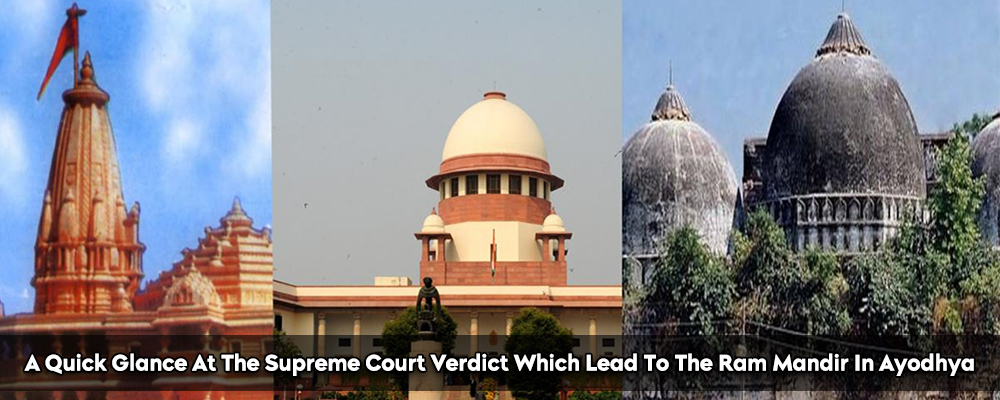As Ayodhya celebrated the Pran Pratishtha of the idol of Shri Ram Lalla, let us take a glance as to what lead to the momentous decision, the verdict of the Supreme Court and what were those evidences which lead to the verdict given by the Apex Court.
The order of the Supreme Court which gave Hindus the possession of the disputed site in Ayodhya depended upon the following key points which the judges drew from the suits and evidences which was presented-
Need A Legal Advice
The internet is not a lawyer and neither are you. Talk to a real lawyer about your legal issue

Possession not proved
- Possession was one of the main claims for the title by the Muslim side, it was claimed that they had possession of the Mosque since the year 1528 and had continued to do so till the year 1949– the time when the idols were placed in the Mosque illegally. Thus, Muslims had the possession of the property by way of adverse possession.
- The claim was rejected by the court as there was evidence which proved that the Hindus had unimpeded access to the parts of the disputed site– hence disqualifying the point that the possession of the property was exclusive.
- “Hindu worship had continued at the Ram Chabutra, Sita Rasoi and various other religious places which included the setting up of a Bhandar- these points clearly indicated their open, exclusive and unimpeded possession of the outer courtyard.
- Also, the Court noted that in connection to the inner courtyard, no evidence was produced in the suit by the Sunni Board to prove an exclusive possession prior to 1857.
Division of the property is not important
- It was suggested by the bench that no distinction could be made between the inner and outer courtyards in order to establish possession and the disputed site must be seen as whole.
- Deciding that exclusion of Hindus from the inner courtyard was a matter of contention, the bench observed that the Hindus offered prayers to the ‘Garbhagriha’ (in the inner courtyard) with belief that the birth-place of Lord Ram was under the central dome of the Mosque.
- The court also said that there was evidence, “on a preponderance of probabilities” to establish that Hindus offered prayers at the inner courtyard prior to the annexation of Oudh by the British in 1857.
- Separation of the courtyard dates back to the 19th century. In the year 1856-57, riots broke out between Hindus and Muslims near the structure. Then the British administration tried to settle a buffer between the two communities by setting up a grill-brick wall and dividing the premises into two parts: the inner courtyard, used by the Muslim community, while the outer courtyard, which was to be used by the Hindu community.
- The courtyard had numerous structures of religious significance for Hindus, including the “Sita Rasoi” as well as the platform called the “Ram Chabutra”.
The case is not about the faith only
- Going against the 2010 Allahabad High Court verdict on the Ram Janmabhoomi-Babri Masjid title suit, which heavily relied on faith and belief, the five-judge bench of the Supreme Court observed that the court title of the property could not be decided on the basis of faith or belief alone but on the basis of evidence.
- The Court kept clear of the arguments based on belief and faith made by the Hindu and Muslim sides and observed that, “whether a belief is justified lies beyond the ken of judicial inquiry. Faith is a matter for the individual believer”.
- The Hindu parties during the course of arguments in the Supreme Court produced historical evidence and cited numerous customs including the ‘parikraman’ in order to show that the devotees have “faith and belief” that the disputed site was indeed the birth place of Lord Ram.
The Report of the ASI was inconclusive
- The excavation report by the Archaeological Survey of India’s (ASI) on the disputed site in Ayodhya had failed to arrive conclusively, if the Hindu Temple was demolished in order to construct a Mosque at the spot in question.
- The lawyers who represented the Hindus, relied heavily on the ASI report in order to assert their right over the 2.77 acre land, while arguing that a Temple was destroyed to construct the Mosque. The accuracy of the report was questioned by the Muslim Party, which accepted the chances of presence of a 12th-century-old Hindu Temple under the disputed site. It was in turn contended by the Muslim side that the excavated structures could be of an ‘Idgah’ or ‘Kanati Masjid.”
- The report of the ASI was submitted on August 22, 2003 on the orders of Allahabad High Court.
- The Five- Judge Bench of the Supreme Court opined that the title to the land should be decided on settled legal principles as well as by applying evidentiary standards governing a civil trial. On the other hand the Sunni Waqf Board’s Idgah defence was dismissed by the court as an afterthought.
- The Court observed that the ASI report did not specifically conclude if a Temple was demolished for the construction of the disputed structure (Mosque) per se. However, what was concluded from the report was that a non-Muslim structure existed prior to the Mosque.
The order of the High Court defied logic
- The Supreme Court observed that the verdict of the Allahabad High Court in the year 2010 trifurcating the disputed site at Ayodhya between the Sunni Waqf Board, Ram Lalla Virajman and the Nirmohi Akhara, which defied logic as well as was contrary to the settled principles of law, hence struck it down. The judges said the “High Court was not seized of a suit for partition”, so it could not divide the land among the contesting parties.
- The Top Court observed that the High Court applied in order to decide the question of title, by the Sunni Wakf board and Ram Lalla Virajman. However, the Court adopted a decision which was not there.
- On September 30, 2010, a three judge bench of the Allahabad High Court comprising Justice SU Khan, Justice Sudhir Agarwal and Justice DV Sharma delivered a judgement holding all the three sets of parties as joint holders of the disputed premises and allotted a one third share to each of them.
In its final judgement the Supreme Court, ruled that entire 2.77 acres of the disputed land in Ayodhya will be handed over to a trust, which has to be constituted for construction of the Ram Temple at the site, also a five acres land should be allotted at a ‘prominent site’ in Ayodhya as well to build a Mosque.
For legal matters, you may contact us at Lead India, as we offer you a team of experienced lawyers who have been successfully dealing with cases related to several fields of law. Therefore, in case you wish to ask a question online or seek free legal advice, you may contact our law firm.





 Talk to a Lawyer
Talk to a Lawyer